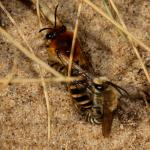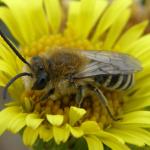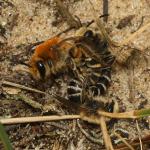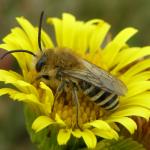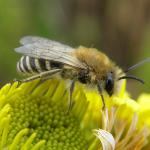Colletes invictus (HARRIS 1776 ); Colletes succinctus invictus (HARRIS 1776)
Originally described as a subspecies of the widely distributed C. succinctus.
This bee is particularly common in East Anglia and by the Thames estuary, but it occurs more sporadically along the southern coast of England. Records for the Channel Islands were misidentifications for Colletes hederae (Schmidt & Westrich).
Listed in Falk (1991) as Nationally Notable (Na).
Associated almost exclusively with coastal habitats. Found on both dunes and the firmer soil behind beaches.
Mid-August to mid-October, and occasionally into early November.
Nesting aggregations, which are sometimes very large, occur in bare soil (e.g. surfaces exposed by land slippage), in artificial mounds of soil, and even in the sides of rabbit burrows. Nesting sites may be subject to occasional inundation by the sea. A nesting aggregation at Scolt Head Island, Norfolk, was reached by the highest spring tides, and the bees were observed trying to reach their burrows, which were submerged in about 7 cm of water (Field & Foster, 1988). On the Norfolk coast, bees have been seen emerging from waterlogged mud (D B Baker, pers. comm.). The nest architecture is similar to that of C. succinctus and has been illustrated by O'Toole and Raw (1991): a cluster of five to six cells radiates from the end of a short, curved burrow. Males may occasionally be found roosting in groups of up to a dozen on grass stems (P Kirby, pers. comm.).
Females visit a wide range of plants for nectar. However, weld (Reseda luteola) is an important nectar source on the east coast of the Wash (C O'Toole, pers. comm.).
C O'Toole (pers. comm.) has reared the parasitic fly Miltogramma punctata (Sarcophagidae) from puparia excavated from nests at Swanscombe Marshes, north Kent. Here, Guichard (1974) observed large numbers of M. punctata and the cleptoparasitic bee Epeolus variegatus flying about the burrow entrances of C. halophilus.
1997
Proofed: March 2012


